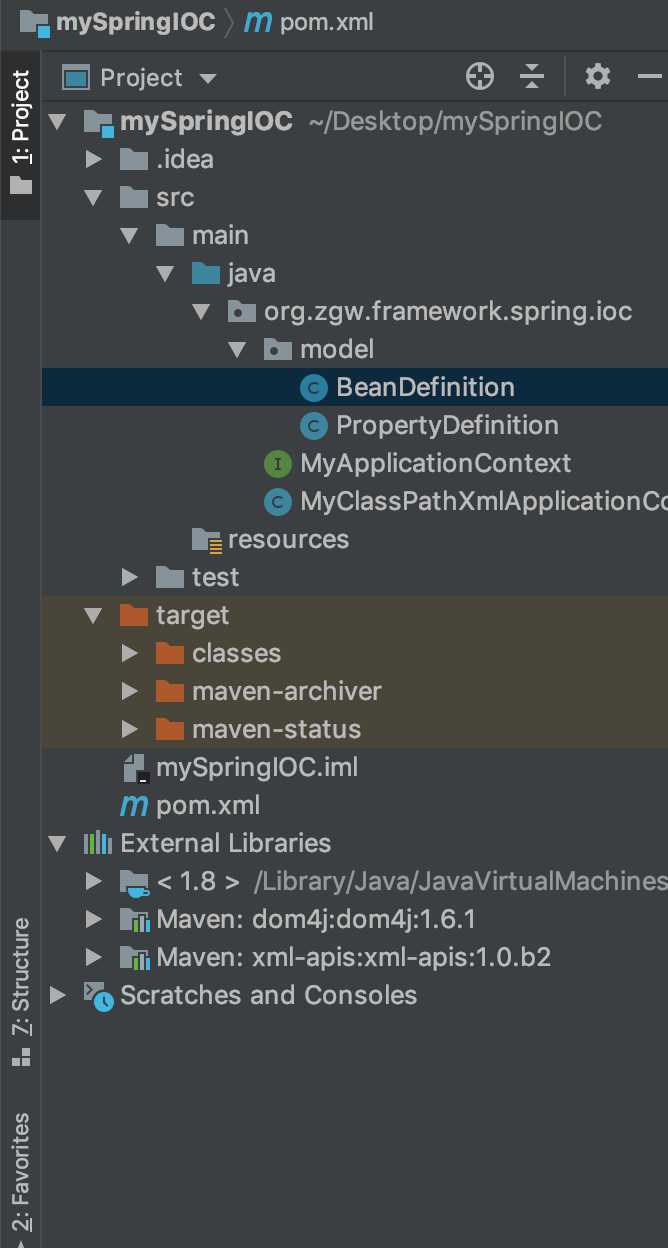标签:resource iat stc 大写 sys maven root alac ash
大家好啊~ 那么今天来带大家写一下spring的ioc。
其实也很简单,首先我们明白两点,java解析xml和java的反射机制,因为ioc就是主要是基于这两个来实现,今天只是简单的来大家实现下。
废话不多说直接上代码。
1.首先加入maven依赖我们这里用到的xml解析是dem4j,先看下项目结构吧。

2.导入maven依赖
1 <?xml version="1.0" encoding="UTF-8"?> 2 <project xmlns="http://maven.apache.org/POM/4.0.0" 3 xmlns:xsi="http://www.w3.org/2001/XMLSchema-instance" 4 xsi:schemaLocation="http://maven.apache.org/POM/4.0.0 http://maven.apache.org/xsd/maven-4.0.0.xsd"> 5 <modelVersion>4.0.0</modelVersion> 6 7 <groupId>com.gd</groupId> 8 <artifactId>mySpringIOC</artifactId> 9 <version>1.0-SNAPSHOT</version> 10 <packaging>jar</packaging> 11 12 <dependencies> 13 <dependency> 14 <groupId>dom4j</groupId> 15 <artifactId>dom4j</artifactId> 16 <version>1.6.1</version> 17 </dependency> 18 </dependencies> 19 </project>
3.首先我们来看MyApplicationContext这个接口
package org.zgw.framework.spring.ioc;
/**
* @DATA 2018-12-30 23:05
* @Author zhangguowei WeChat:17630376104
* @Description TODO
*/
public interface MyApplicationContext {
Object getBean(String beanId);
Object getBean(Class clazz);
}
这个接口中有个两个getbBean();重栽的方法。这两个接口也就是ioc的id大家用过spring 的应该都知道,这里不过多的解释。
4.接着看我们的MyClassPathXmlApplicationContext这个实现类。
package org.zgw.framework.spring.ioc;
import org.dom4j.Document;
import org.dom4j.DocumentException;
import org.dom4j.Element;
import org.dom4j.io.SAXReader;
import org.zgw.framework.spring.ioc.model.BeanDefinition;
import org.zgw.framework.spring.ioc.model.PropertyDefinition;
import java.io.InputStream;
import java.lang.reflect.InvocationTargetException;
import java.lang.reflect.Method;
import java.util.Collection;
import java.util.HashMap;
import java.util.List;
import java.util.Map;
/**
* @DATA 2018-12-30 23:07
* @Author zhangguowei WeChat:17630376104
* @Description TODO
*/
public class MyClassPathXmlApplicationContext implements MyApplicationContext {
private Map<String, BeanDefinition> stringBeanDefinitionMap = new HashMap<String, BeanDefinition>();
public MyClassPathXmlApplicationContext(String xmlName) {
loadXml(xmlName);
}
private void loadXml(String xmlName) {
SAXReader reader = new SAXReader();
//读取xml
InputStream inputStream = Thread.currentThread().getContextClassLoader().getResourceAsStream(xmlName);
try {
Document document = reader.read(inputStream);
// 获取标签
Element element = document.getRootElement();
System.out.println("根节点:" + element.getName());
List<Element> elementList = element.elements();
for (Element beanlist : elementList) {
System.out.println("子节点:" + beanlist.getName() + "\t" + beanlist.attributeValue("id") + "\t" + beanlist.attributeValue("class"));
BeanDefinition beanDefinition = new BeanDefinition();
//读取name的值
beanDefinition.setName(beanlist.attributeValue("name"));
//读取class的值
beanDefinition.setClassStr(beanlist.attributeValue("class"));
List<Element> proList = beanlist.elements();
for (Element element1 : proList) {
System.out.println(element1.getName() + "\t" + element1.attributeValue("name") + "\t" + element1.getText());
PropertyDefinition propertyDefinition = new PropertyDefinition();
propertyDefinition.setName(element1.attributeValue("name"));
propertyDefinition.setValue(element1.attributeValue("value"));
beanDefinition.getPropertyDefinitionMap().put(propertyDefinition.getName(), propertyDefinition);
}
stringBeanDefinitionMap.put(beanDefinition.getName(), beanDefinition);
}
} catch (DocumentException e) {
e.printStackTrace();
}
}
public Object getBean(String beanId) {
BeanDefinition beanDefinition = stringBeanDefinitionMap.get(beanId);
String clazzStr = beanDefinition.getClassStr();
Object beanobj = null;
try {
Class clazz = Class.forName(clazzStr);
beanobj = clazz.newInstance();
// 给属性赋值
Collection<PropertyDefinition> propertyDefinitions = beanDefinition.getPropertyDefinitionMap().values();
for (PropertyDefinition propertyDefinition : propertyDefinitions) {
String setterMethodStr = propertyDefinition.getName();
//因为spring读的是他个set方法,一般set方法都为大写开头所以这里进行转换
String firstChar = setterMethodStr.substring(0, 1).toUpperCase();
setterMethodStr = "set" + firstChar + setterMethodStr.substring(1);
System.out.println("-------- 拼接出来的set方法" + setterMethodStr);
Method setMathod= clazz.getMethod(setterMethodStr,String.class);
setMathod.invoke(beanobj,propertyDefinition.getValue());
}
} catch (ClassNotFoundException e) {
e.printStackTrace();
} catch (IllegalAccessException e) {
e.printStackTrace();
} catch (InstantiationException e) {
e.printStackTrace();
} catch (NoSuchMethodException e) {
e.printStackTrace();
} catch (InvocationTargetException e) {
e.printStackTrace();
}
return beanobj;
}
public Object getBean(Class clazz) {
return null;
}
}
基本的注释我都写有,这些大家应该能看的懂。
5.还有一点就是两个实体的类,因为她们得对应spring的属性
package org.zgw.framework.spring.ioc.model;
import java.util.HashMap;
import java.util.Map;
/**
* @DATA 2018-12-30 23:15
* @Author zhangguowei WeChat:17630376104
* @Description TODO
*/
public class BeanDefinition {
private String name;
private String classStr;
private Map<String, PropertyDefinition> propertyDefinitionMap = new HashMap<String, PropertyDefinition>();
public String getName() {
return name;
}
public void setName(String name) {
this.name = name;
}
public String getClassStr() {
return classStr;
}
public void setClassStr(String classStr) {
this.classStr = classStr;
}
public Map<String, PropertyDefinition> getPropertyDefinitionMap() {
return propertyDefinitionMap;
}
public void setPropertyDefinitionMap(Map<String, PropertyDefinition> propertyDefinitionMap) {
this.propertyDefinitionMap = propertyDefinitionMap;
}
}
package org.zgw.framework.spring.ioc.model;
/**
* @DATA 2018-12-30 23:17
* @Author zhangguowei WeChat:17630376104
* @Description TODO
*/
public class PropertyDefinition
{
private String name;
private String value;
public String getName() {
return name;
}
public void setName(String name) {
this.name = name;
}
public String getValue() {
return value;
}
public void setValue(String value) {
this.value = value;
}
}
这个只是基于xml的ioc,直接上代码,可以拷贝走尝试下,方便大家理解。后续还有ioc的注解方式实现。
标签:resource iat stc 大写 sys maven root alac ash
原文地址:https://www.cnblogs.com/zgwjava/p/10202027.html